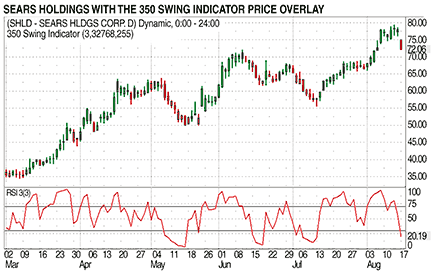TRADING STRATEGIES
The Start And The Finish
The 350 Swing Trade
This indicator can help you identify the beginning and end of a price swing.
When markets exhibit greater and greater volatility, traders move away from longer-term trading methods with their potentially devastating drawdowns and move toward more nimble strategies that catch shorter-term price moves. Among the many short-term trading methods, swing trading, with its emphasis on trades that last from a few days to a few weeks, offers a good middle ground that makes trading more manageable.
Traders may use a variety of methods to identify the beginnings and endings of a price swing. They include patterns formed by price bars or candlesticks, support/resistance zones, pullbacks in an existing trend, Fibonacci levels, or momentum indicators. The approach used in this article is based on the relative strength index (Rsi), a momentum indicator developed by J. Welles Wilder.
The 350 swing indicator
The Rsi identifies potentially overbought and oversold levels at which price may reverse direction. However, its default lookback period of 14 does not work well to identify short-term price swings. It tends to remain in a type of no-man’s land between its 30 and 70 levels for long periods, catching fairly large drawdowns before reaching overbought or oversold levels.
Decreasing the lookback period increases the indicators’ sensitivity to smaller price moves — sometimes too much. That was the case when I changed the 14-period Rsi to a three-period Rsi (see sidebar “Rsi 3”). The result was numerous false signals.
However, further observation revealed that the beginnings and endings of price swings often occur when the three-period Rsi moves above or below its 50 level rather than the usual oversold/overbought levels of 30 and 70. And the tendency to remain in limbo between overbought and oversold levels, counterproductive with a longer lookback period, is ideal for enabling short-term traders to remain with an uptrend while the Rsi 3 is above its 50 level and with a downtrend when it is below the 50 level.
To make the directional transition from down to up and from up to down easier to identify, the price bars are colored to reflect the position of the Rsi 3 in relation to its 50 line with green bars above and red bars below. I named the price overlay study the 350 swing indicator (see sidebar “350 Swing Indicator”).

Figure 1: Sears Holdings with the 350 Swing Indicator. The red and green colors of the 350 swing indicator overlay price. The indicator, based on Wilder’s relative strength index (RSI), identifies short-term price swings.
The 2009 chart of Sears Holdings (Shld) in Figure 1 displays the red and green bars of the 350 swing indicator on price and the Rsi 3 in the panel under the chart. Candlesticks are used for the purpose of easier viewing and in this article are referred to as price bars. Their color is not related to the open and close relationship of price, only to the position of the 350 swing indicator in relation to its 50 level.